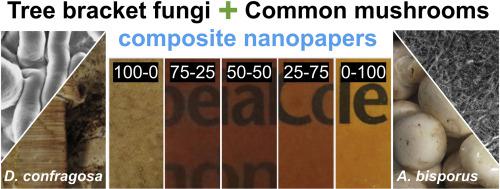当前位置:
X-MOL 学术
›
Compos. Sci. Technol.
›
论文详情
Our official English website, www.x-mol.net, welcomes your
feedback! (Note: you will need to create a separate account there.)
Plastic to elastic: Fungi-derived composite nanopapers with tunable tensile properties
Composites Science and Technology ( IF 8.3 ) Pub Date : 2020-09-01 , DOI: 10.1016/j.compscitech.2020.108327 Wan M.F.W. Nawawi , Mitchell P. Jones , Eero Kontturi , Andreas Mautner , Alexander Bismarck
Composites Science and Technology ( IF 8.3 ) Pub Date : 2020-09-01 , DOI: 10.1016/j.compscitech.2020.108327 Wan M.F.W. Nawawi , Mitchell P. Jones , Eero Kontturi , Andreas Mautner , Alexander Bismarck

|
Abstract Fungal chitin is attracting commercial and academic interest as a cheap, renewable, easily isolated and abundant alternative to crustacean chitin. Being covalently decorated with β-glucan, fungal chitin exhibits a native nanocomposite architecture that varies in fibre diameter and chitin to β-glucan ratio from species to species, resulting in mechanical properties ranging from brittle, high tensile strength, plastic-like properties to very tough and elastomeric rubber-like tensile properties if processed into paper form. This study utilised a mild alkaline process to extract chitin-β-glucan complexes from tree bracket fungi (D. confragosa) and common mushrooms (A. bisporus), which were then combined in varying ratios and hot pressed to form engineered composite nanopapers with tunable tensile properties. Fruiting bodies of common mushrooms, with almost proportional contents of chitin and β-glucan, exhibited a nanofibrous architecture resulting in very high tensile strengths, far outperforming crustacean-derived chitin. These nanopapers could then be plasticised in a controlled fashion through addition of extract from tree bracket fungi, which contains large quantities of β-glucan, to produce composite nanopapers. The fungal chitin extracts were significantly more hydrophobic than crustacean chitin, suggesting potential as a coating agent for hydrophilic materials, such as cellulose. These remarkable and controllable characteristics make fungi-derived materials versatile for a wide range of applications, including coatings, membranes, packaging and paper.
中文翻译:

塑性至弹性:具有可调拉伸性能的真菌衍生复合纳米纸
摘要 真菌几丁质作为甲壳类几丁质的廉价、可再生、易于分离和丰富的替代品,正在吸引商业和学术兴趣。真菌几丁质与 β-葡聚糖共价装饰,呈现出一种天然纳米复合结构,其纤维直径和几丁质与 β-葡聚糖的比例因物种而异,导致机械性能从脆性、高拉伸强度、类塑料性能到非常如果加工成纸状,坚韧和弹性橡胶般的拉伸性能。本研究利用弱碱性工艺从树支架真菌(D. confragosa)和普通蘑菇(A. bisporus)中提取几丁质-β-葡聚糖复合物,然后将它们以不同的比例组合并热压形成具有可调的工程复合纳米纸拉伸性能。普通蘑菇的子实体,几丁质和β-葡聚糖的含量几乎成比例,呈现出纳米纤维结构,具有非常高的拉伸强度,远远优于甲壳类动物来源的几丁质。然后可以通过添加含有大量β-葡聚糖的树支架真菌提取物以受控方式对这些纳米纸进行塑化,以生产复合纳米纸。真菌几丁质提取物的疏水性明显高于甲壳类几丁质,表明其具有作为亲水性材料(如纤维素)涂层剂的潜力。这些卓越且可控的特性使真菌衍生材料具有广泛的用途,包括涂料、膜、包装和纸张。表现出纳米纤维结构,具有非常高的拉伸强度,远远优于甲壳类动物衍生的几丁质。然后可以通过添加含有大量β-葡聚糖的树支架真菌提取物以受控方式对这些纳米纸进行塑化,以生产复合纳米纸。真菌几丁质提取物的疏水性明显高于甲壳类几丁质,表明其具有作为亲水性材料(如纤维素)涂层剂的潜力。这些卓越且可控的特性使真菌衍生材料具有广泛的用途,包括涂料、膜、包装和纸张。表现出纳米纤维结构,具有非常高的拉伸强度,远远优于甲壳类动物衍生的几丁质。然后可以通过添加含有大量β-葡聚糖的树支架真菌提取物以受控方式对这些纳米纸进行塑化,以生产复合纳米纸。真菌几丁质提取物的疏水性明显高于甲壳类几丁质,表明其具有作为亲水性材料(如纤维素)涂层剂的潜力。这些卓越且可控的特性使真菌衍生材料具有广泛的用途,包括涂料、膜、包装和纸张。然后可以通过添加含有大量β-葡聚糖的树支架真菌提取物以受控方式对这些纳米纸进行塑化,以生产复合纳米纸。真菌几丁质提取物的疏水性明显高于甲壳类几丁质,表明其具有作为亲水性材料(如纤维素)涂层剂的潜力。这些卓越且可控的特性使真菌衍生材料具有广泛的用途,包括涂料、膜、包装和纸张。然后可以通过添加含有大量β-葡聚糖的树支架真菌提取物以受控方式对这些纳米纸进行塑化,以生产复合纳米纸。真菌几丁质提取物的疏水性明显高于甲壳类几丁质,表明其具有作为亲水性材料(如纤维素)涂层剂的潜力。这些卓越且可控的特性使真菌衍生材料具有广泛的用途,包括涂料、膜、包装和纸张。
更新日期:2020-09-01
中文翻译:

塑性至弹性:具有可调拉伸性能的真菌衍生复合纳米纸
摘要 真菌几丁质作为甲壳类几丁质的廉价、可再生、易于分离和丰富的替代品,正在吸引商业和学术兴趣。真菌几丁质与 β-葡聚糖共价装饰,呈现出一种天然纳米复合结构,其纤维直径和几丁质与 β-葡聚糖的比例因物种而异,导致机械性能从脆性、高拉伸强度、类塑料性能到非常如果加工成纸状,坚韧和弹性橡胶般的拉伸性能。本研究利用弱碱性工艺从树支架真菌(D. confragosa)和普通蘑菇(A. bisporus)中提取几丁质-β-葡聚糖复合物,然后将它们以不同的比例组合并热压形成具有可调的工程复合纳米纸拉伸性能。普通蘑菇的子实体,几丁质和β-葡聚糖的含量几乎成比例,呈现出纳米纤维结构,具有非常高的拉伸强度,远远优于甲壳类动物来源的几丁质。然后可以通过添加含有大量β-葡聚糖的树支架真菌提取物以受控方式对这些纳米纸进行塑化,以生产复合纳米纸。真菌几丁质提取物的疏水性明显高于甲壳类几丁质,表明其具有作为亲水性材料(如纤维素)涂层剂的潜力。这些卓越且可控的特性使真菌衍生材料具有广泛的用途,包括涂料、膜、包装和纸张。表现出纳米纤维结构,具有非常高的拉伸强度,远远优于甲壳类动物衍生的几丁质。然后可以通过添加含有大量β-葡聚糖的树支架真菌提取物以受控方式对这些纳米纸进行塑化,以生产复合纳米纸。真菌几丁质提取物的疏水性明显高于甲壳类几丁质,表明其具有作为亲水性材料(如纤维素)涂层剂的潜力。这些卓越且可控的特性使真菌衍生材料具有广泛的用途,包括涂料、膜、包装和纸张。表现出纳米纤维结构,具有非常高的拉伸强度,远远优于甲壳类动物衍生的几丁质。然后可以通过添加含有大量β-葡聚糖的树支架真菌提取物以受控方式对这些纳米纸进行塑化,以生产复合纳米纸。真菌几丁质提取物的疏水性明显高于甲壳类几丁质,表明其具有作为亲水性材料(如纤维素)涂层剂的潜力。这些卓越且可控的特性使真菌衍生材料具有广泛的用途,包括涂料、膜、包装和纸张。然后可以通过添加含有大量β-葡聚糖的树支架真菌提取物以受控方式对这些纳米纸进行塑化,以生产复合纳米纸。真菌几丁质提取物的疏水性明显高于甲壳类几丁质,表明其具有作为亲水性材料(如纤维素)涂层剂的潜力。这些卓越且可控的特性使真菌衍生材料具有广泛的用途,包括涂料、膜、包装和纸张。然后可以通过添加含有大量β-葡聚糖的树支架真菌提取物以受控方式对这些纳米纸进行塑化,以生产复合纳米纸。真菌几丁质提取物的疏水性明显高于甲壳类几丁质,表明其具有作为亲水性材料(如纤维素)涂层剂的潜力。这些卓越且可控的特性使真菌衍生材料具有广泛的用途,包括涂料、膜、包装和纸张。











































 京公网安备 11010802027423号
京公网安备 11010802027423号